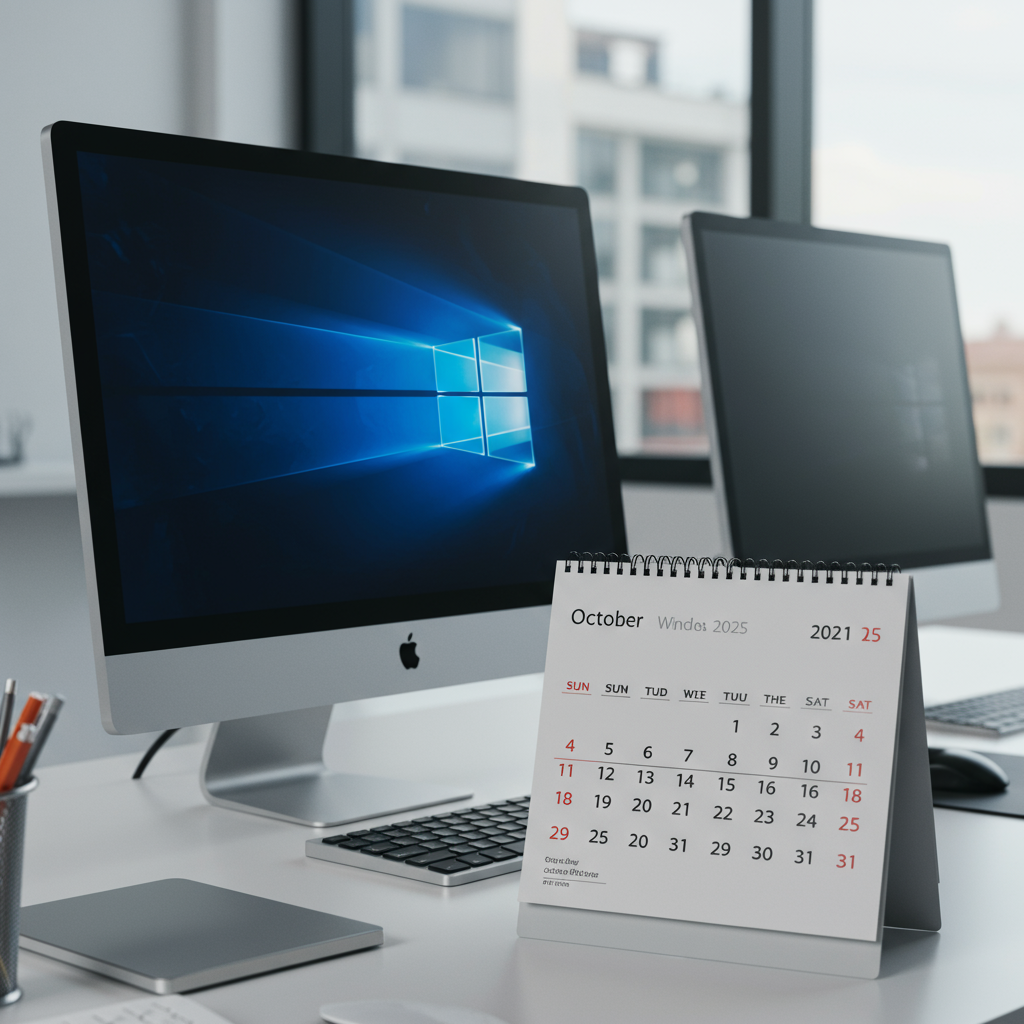October 14, 2025. That date marks a critical deadline for businesses worldwide still running <a href="https://news.quantosei.com/2025/06/29/i-think-xbox-hardware-is-dead-says-microsoft-gaming-veteran/” title=”Explosive: Microsoft Vet Claims Xbox Hardware Is Dead”>windows 10. With support scheduled to cease entirely, millions of enterprise PCs face a future without vital security updates, opening the door to potentially devastating cyberattacks. Recent data paints a clear picture: a significant number of companies are lagging behind on their migration to Windows 11, leaving them vulnerable as the clock ticks down. Understanding the scope of this challenge and the available options is crucial for maintaining security and operational continuity.
The Unsettling Reality: Millions Remain on Windows 10
Despite Microsoft’s long-standing roadmap and the proximity of the end-of-support date, a substantial portion of the business world hasn’t yet made the leap to Windows 11. A new readiness report from ControlUp reveals that half of all professionally managed Windows devices are still operating on the Windows 10 platform. While this represents progress compared to previous years, when over 80% were Windows 10 machines, the remaining installed base is massive. Estimates suggest potentially hundreds of millions of PCs could remain on Windows 10 past the deadline. This creates a widespread vulnerability that cybercriminals are likely to exploit. The transition rate, even if accelerating, is simply not fast enough for many organizations to meet the October 2025 cutoff without leaving significant systems exposed.
Why Migration is Stalling for Many
Several factors contribute to the slow pace of migration within businesses. For some, particularly in sectors like healthcare and finance, outdated hardware is a major obstacle. A notable percentage of devices in these industries simply don’t meet Windows 11’s minimum system requirements, such as the need for TPM 2.0 and Secure Boot capabilities. Replacing or upgrading these machines requires significant capital investment and logistical planning.
However, hardware isn’t the only challenge. Even for devices technically capable of running Windows 11, the transition can be complex. Enterprise IT environments are often intricate, with legacy applications and dependencies that must be tested for compatibility. Larger organizations managing tens of thousands of devices face particularly daunting planning and deployment hurdles, slowing their migration completion rates. This isn’t just a technical problem; it’s also a strategic and resource allocation challenge.
Uneven Progress Across Industries and Regions
The ControlUp report highlighted significant disparities in migration progress depending on the sector and geographic location. Leading the charge are the education and technology industries, with over 70% of their systems already upgraded to Windows 11. This likely reflects a greater emphasis on modern IT infrastructure and faster hardware refresh cycles within these fields.
In stark contrast, the healthcare and finance sectors are notably behind, with fewer than half of their devices running the newer operating system. The issue of aging hardware is particularly pronounced in healthcare, where nearly a fifth of devices may require replacement before an upgrade is even feasible. Regionally, the Americas lag behind Europe in adopting Windows 11 within the enterprise landscape. Only about 43% of devices in the Americas have transitioned, compared to a robust 70% in Europe, even though many un-upgraded machines in the Americas could technically make the switch.
The Critical Risks of Running an Unsupported OS
Using Windows 10 after its end-of-support date carries substantial risks that businesses cannot afford to ignore. The primary danger is the cessation of free security updates delivered through Windows Update. Without these patches, newly discovered vulnerabilities will remain unaddressed, creating easy entry points for malware, ransomware, and other cyber threats. Relying solely on third-party antivirus software is not a sufficient safeguard against these evolving exploits.
An unsupported operating system becomes an attractive target for attackers, potentially exposing sensitive business data, disrupting operations, and incurring significant costs related to incident response and recovery. While Windows 10 will continue to function, the lack of security patches turns perfectly good hardware into a potential liability, threatening both individual systems and the wider corporate network. Past incidents, like widespread malware outbreaks leveraging vulnerabilities in unsupported OS versions, serve as stark warnings about the potential consequences.
Options for Businesses Facing the Deadline
For organizations still heavily reliant on Windows 10, several paths exist to navigate the end-of-support cliff. Deciding on the right approach depends on hardware readiness, budget, and IT strategy.
The most straightforward solution for compatible hardware is a direct upgrade to Windows 11. This involves checking device specifications (CPU, TPM, Secure Boot), planning a phased rollout to minimize disruption, and prioritizing critical systems. Replacing hardware that doesn’t meet the minimum requirements is also part of this pathway, offering an opportunity to standardize on modern, supported equipment. Developing a clear migration plan and timeline is essential to execute this effectively before the deadline arrives.
For businesses that cannot complete the Windows 11 migration or have a significant number of incompatible machines, Microsoft offers the Extended Security Updates (ESU) program. This paid subscription provides continued security patches for Windows 10 devices for up to three years beyond the original end-of-support date. While it offers a critical safety net, the cost increases significantly each year, making it a temporary bridge rather than a long-term solution. For business customers, the annual cost per PC escalates considerably over the three-year period. Third-party providers are also developing their own patching solutions, offering potential alternatives, though these come with their own considerations.
Other options include strategically replacing older hardware with new Windows 11 compatible PCs, or, in more complex scenarios, exploring virtual desktop solutions that allow access to Windows 11 environments from older hardware. While technically possible to bypass compatibility checks and install Windows 11 on unsupported hardware, this is not officially endorsed by Microsoft, carries inherent risks, and means the system may not be “entitled” to future updates, making it a risky strategy for a business environment focused on stability and security. Switching to an alternative operating system like Linux is also an option but is often impractical for businesses deeply integrated into the Windows ecosystem.
Taking Action: What Businesses Should Do Now
With the October 2025 deadline rapidly approaching, inaction is the riskiest strategy. Businesses must proactively assess their Windows 10 footprint and develop a plan.
Begin by conducting a thorough inventory of all Windows 10 devices. Utilize management tools to check each machine against Windows 11’s specific hardware requirements. Identify which devices are compatible with an upgrade and which will require replacement.
Next, develop a clear migration strategy. This might involve phased upgrades for compatible devices, budgeting for new hardware purchases, or planning for enrollment in the ESU program for systems that cannot be immediately upgraded or replaced. Prioritize the most critical or exposed systems for transition or risk mitigation.
For devices that will remain on Windows 10 after the deadline, even with ESU, implement additional layers of security. Ensure robust antivirus and malware protection are in place. Limit network access for outdated systems, especially those containing sensitive data. Consider isolating particularly vulnerable devices to prevent potential breaches from spreading. Maintaining all available Windows 10 updates before the deadline is also crucial.
The end of Windows 10 support is not just an IT challenge; it’s a business imperative. Failure to act exposes organizations to significant cybersecurity risks, potential operational disruption, and compliance issues. Proactive planning and investment now are essential to ensure a secure and seamless transition.
Frequently Asked Questions
When exactly does Microsoft end support for Windows 10?
Microsoft will officially end mainstream support for most editions of Windows 10, including Home, Pro, Pro Workstation, Enterprise, and Education, on October 14, 2025. After this date, these versions will no longer receive free security updates or non-security fixes through Windows Update, making them increasingly vulnerable to new cyber threats.
What are the main options for businesses with PCs that can’t upgrade to Windows 11?
For Windows 10 PCs that don’t meet Windows 11 hardware requirements, businesses have a few options. The most recommended is replacing the hardware with Windows 11 compatible devices. Alternatively, they can enroll in Microsoft’s paid Extended Security Updates (ESU) program for up to three years of continued security patches. Implementing strict security measures, like isolation and enhanced protection, is also advised alongside these options.
Why is it risky for businesses to keep using Windows 10 after the deadline?
Continuing to use Windows 10 after October 14, 2025, without paid security updates poses significant risks because Microsoft will stop releasing free patches for newly discovered vulnerabilities. This leaves systems exposed to evolving malware, ransomware, and other attacks. An unpatched OS can become an easy target for cybercriminals, potentially leading to data breaches, network compromise, and costly business disruption.



